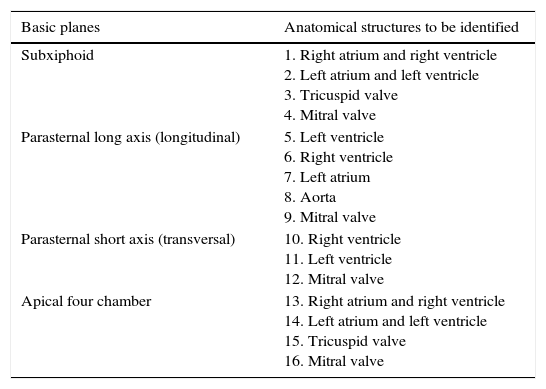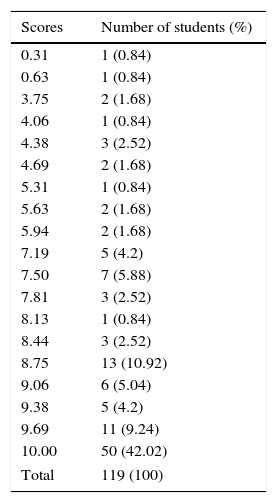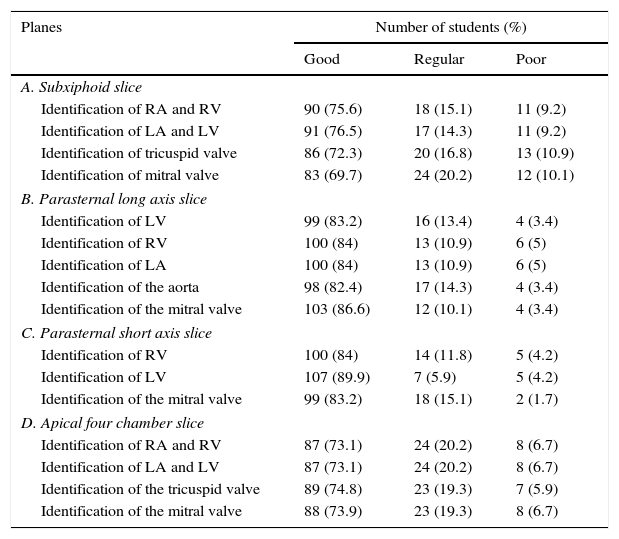To analyze the ability of medical students to incorporate the practical teaching of basic echocardiography planes using a peer mentoring design.
MethodologyThirty-six medical students previously trained in obtaining echocardiography planes (mentors) taught the other 5th-year students (n=126). The teaching methodology included three stages: theory (online course), basic training (three 15h sessions of practical experience in ultrasound and at least 20 echocardiographic studies per mentor) and objective structured clinical assessment (OSCA), which scored the appropriateness of the basic ultrasound planes and the correct identification of 16 cardiac structures.
ResultsThe students’ weighted mean score in the OSCA was 8.66±1.98 points (out of 10). Only 10 students (8.4%) scored less than 5, and 15 (12.6%) scored less than 7. Fifty students (42%) scored 10 points. The most easily identified structure was the left ventricle in the short-axis parasternal plane, with 89.9% of correct answers. The most poorly identified structure was the mitral valve in the subxiphoid plane, with 69.7% of correct answers.
ConclusionsPeer mentoring-based teaching achieves an appropriate level of training in obtaining basic echocardiography planes. The training period is relatively short. The peer mentoring system can facilitate the implementation of teaching on basic aspects of ultrasound to a large number of undergraduate students.
Analizar la capacidad de los alumnos de Medicina para integrarse en la enseñanza práctica de los planos básicos en ecocardioscopia mediante un diseño de mentoría paritaria.
MetodologíaTreinta y seis alumnos de Medicina previamente adiestrados en la obtención de planos en ecocardioscopia (mentores) enseñaron al resto de alumnos de 5.o curso (n=126). La metodología docente incluyó 3 etapas: teoría (curso online), entrenamiento básico (3 sesiones con 15h de experiencia práctica en ultrasonidos y un mínimo de 20 estudios ecocardiográficos por mentor) y evaluación clínica objetiva estructurada (ECOE) en la que se puntuaba la adecuación de los planos ecográficos básicos y la correcta identificación de 16 estructuras cardiacas.
ResultadosLa puntuación media ponderada obtenida por los alumnos en la ECOE fue de 8,66±1,98 puntos (sobre un máximo de 10). Solo 10 alumnos (8,4%) obtuvieron una puntuación inferior a 5 y 15 (12,6%) inferior a 7. Cincuenta alumnos (42%) obtuvieron 10 puntos. La estructura más fácilmente identificada fue el ventrículo izquierdo en el plano paraesternal eje corto, con un 89,9% de respuestas correctas. La estructura peor identificada fue la válvula mitral en el plano subxifoideo, con un 69,7% de respuestas correctas.
ConclusionesLa enseñanza basada en la mentoría paritaria consigue un nivel de entrenamiento adecuado en la obtención de planos básicos en la ecocardioscopia. El periodo de formación es relativamente corto. El sistema de mentoría paritaria puede facilitar la implantación de la enseñanza sobre aspectos básicos en ultrasonidos a un elevado número de alumnos de pregrado.
Article
Diríjase desde aquí a la web de la >>>FESEMI<<< e inicie sesión mediante el formulario que se encuentra en la barra superior, pulsando sobre el candado.

Una vez autentificado, en la misma web de FESEMI, en el menú superior, elija la opción deseada.

>>>FESEMI<<<









